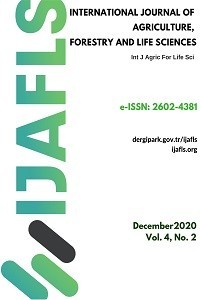GIBBERELLIN APPLICATION INFLUENCES ON EX VITRO GROWTH, FLOWERING AND STEVIOL GLYCOSIDE ACCUMULATION OF STEVIA REBAUDIANA BERTONI
GIBBERELLIN APPLICATION INFLUENCES ON EX VITRO GROWTH, FLOWERING AND STEVIOL GLYCOSIDE ACCUMULATION OF STEVIA REBAUDIANA BERTONI
___
- BRANDLE JE, ROSA, N. 1992. Heritability for yield, leaf:stem ratio and stevioside content estimated from a landrace cultivar of Stevia rebaudiana. Can. J. Plant Sci.72:1263-1266BRANDLE JE, TELMER PG. 2007. Steviol glycoside biosynthesis. Phytochem. 68: 1855-1863
- BONDAREV N, RESHETNYAK O, NOSOV A. 2003. Effects of nutrient medium composition on development of Stevia rebaudiana shoots cultivated in the roller bioreactor and their production of steviol glycosides. Plant Sci. 165:845-850BONDAREV NI, SUKHANOVA MA, RESHETNYAK OV, NOSOV AM. 2003. Steviol glycoside content in different organs of Stevia rebaudiana and its dynamics during ontogeny, Biol. Plantarum 47:261–264
- BRIAN, P.W. 1958. Role of gibberellin-like hormones in regulation of plant growth and flowering. Nat. Land. 181:1122CARDOSO JC, ONO EO, RODRIGUES JD. 2012. Gibberellic acid in vegetative and reproductive development of Phalaenopsis orchid hybrid genus. Horticultura Brasileira 30: 71-74
- CEUNEN S, GEUNS JMC. 2013. Glucose, sucrose, and steviol glycoside accumulation inStevia rebaudiana grown under different photoperiods. Biologia Plantarum. 57 (2): 390-394CEUNEN S, WERBROUCK S, GEUNS JMC. 2012. Stimulation of steviol glycoside accumulation in Stevia rebaudiana by red LED light. J. Plant Physiol. 169: 749-752
- HASSANPOURAGHDAM MB, HAJISAMADI ASL B, KHALIGHI A. 2011.Gibberellic acid foliar application influences growth, volatile oil and some physiological characteristics of lavender (Lavandula officinalis Chaix.). Romanian Biotech Letters. 16 (4):6322KINGHORN AD, SOEJARTO DD. 1985. Current status of stevioside as a sweetening agent for human use. In: Wagner, H., Hikiro, H., Farnsworth, H. R. (Eds.), Economic and Med Plant Res. Academic Press, New York, 1(1):52
- LANG A. REINHARD E. 1961. Gibberellins. In: Gibberellins and flower formation. Advances in Chemistry. 28:71-79MEDINA E.O. SAAVEDRA A.L. 1999. The use of regulators in floriculture Mexican. Sci. Desar, Bogota., 148: 1-17.
- MODI AR, SHUKLA YM, LITORIYA NS, PATEL NJ, UBHASH N. 2011.Effect of gibberellic acid foliar spray on growth and stevioside content of ex vitro grown plants of Stevia rebaudiana Bertoni. Med Plants Int. J. Phytomedicines Relat. Ind. 3(2):157-160PABLO MORALES-PAYAN J. 2005. Growth of aromatic coleus (Coleus amboinus Lour.) as affected by biostimulators. Proceedings of 33rd PGRSA Annual meeting, 210-212
- PAL PK, RASAD R, PATHANIA V. 2013. Effect of decapitation and nutrient applications on shoot branching, yield, and accumulation of secondary metabolites in leaves of Stevia rebaudiana Bertoni. J of Plant Physiol.70: 1526– 1535RAMESH K, VIRENDRA S, MEGEJI NW. 2006. Cultivation of stevia [Stevia rebaudiana (Bert.) Bertoni]: A comprehensive review. Adv Agron 89: 137–177
- SERFATY M, IBDAHA M, FISCHERA R, CHAIMOVITSHA D, SARANGAB Y, DUDAI N. 2013. Dynamics of yield components and stevioside production in Stevia rebaudiana grown under different planting times, plant stands and harvest regime. Industrial Crops and Products 50:731– 736 STATISTICAL TOOL FOR AGRICULTURAL RESEARCH (STAR). 2013.Plant Breeding Genetics and Biotechnology. Biometrics and Breeding Informatics (BBI). International Rice Research Institute.
- STRIEDNER J, GEISSLER S, CZYGANF-C, BRAUNEGG G. 1991. Contributions to the biotechnolgical production of sweeteners from Stevia rebaudiana Bertoni. III. Accumulation of secondary metabolites by means of a precursor and by elicitation of cellcultures.Acta Biotechnologica 119(5):505–509TAIZ L, ZEIGER E. 2010. Plant Physiology in the Fifth Edition. Sinauer Associates Inc.,Publishers, Sunderland, Massachusetts, U.S.A.
- Yayın Aralığı: Yılda 2 Sayı
- Başlangıç: 2017
- Yayıncı: Volkan OKATAN
İlker SÖNMEZ, Hüseyin KALKAN, Halil DEMİR, Recep KÜLCÜ, Osman YALDIZ, Mustafa KAPLAN
EFFECT OF SEAWEED EXTRACT (SE) ON SEED GERMINATION CHARACTERISTICS OF WHEAT IN SALTY CONDITIONS
AGRICULTURAL DEVELOPMENT LED INDUSTRIALIZATION IN ETHIOPIA: STRUCTURAL BREAK ANALYSIS
Ahmed Kasim DUBE, Wasiu Olayinka FAWOLE, Ramu GOVİNDASAMY, Burhan ÖZKAN
EFFECTS OF CALCIUM ASCORBATE AND CALCIUM LACTATE ON QUALITY OF FRESH-CUT PINEAPPLE (Ananas comosus)
Roden TROYO, Antonio Jr. ACEDO
Catherine ARRADAZA, Ma. Lourdes O. CEDO, Rocelie R. ZARA, Rachel Ann GONZAGA
AN EVALUATION OF NITROGEN FERTILITY MANAGEMENT IN COMMERCIAL POTATO FIELDS
SOME ANIMAL OFFERINGS IN THE HITTITE RELIGIOUS RITUALS
EFFECTS OF GLOBAL WARMING ON ANIMAL BREEDING
Sibel ALAPALA DEMİRHAN, Nuray ŞAHİNLER
Metin Göksel AKPINAR, Mevlüt GÜL, Yavuz TAŞCIOĞLU, Bahri KARLI, Yalçın BOZKURT
